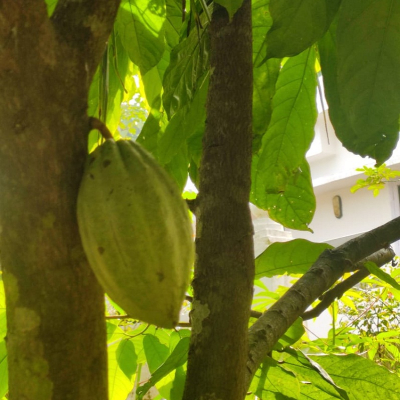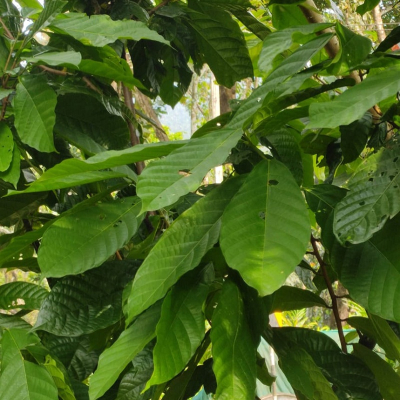Distribution and habitat: Native of Central and South Africa.
Botany: A wide branching evergreen tree, reaching 5-8 m in height. Twigs pubescent.
- Leaves : Alternate, oblong-oval or elliptic-oblong, entire, short petioled, the blade 15 cm long more or less, rounded at the base, abruptly acuminate, with strong midrib and paired or somewhat alternate arching side veins.
- Flowers : Small, in fascicles directly on the bark of the trunk and main branches, about 2 cm across when expanded. Pedicels slender, 12 mm or more long. Calyx rose-coloured; segments acuminate. Corolla yellowish; petals with a stalk like claw and expanded blade.
- Fruits : 30 cm long or shorter, red, yellow, purplish or brown, elliptic-ovoid, the rind thick, hard and leathery. Cells 5, each with 5-12 seeds in a row imbedded in a white or pinkish acid pulp.
Properties: Stimulant
Uses: Used as nutritive and stimulant.
Agrotechnology
Soil and climate: Cocoa grows on a wide range of soils but loose soils which allow root penetration and movement of air and moisture are ideal. Though cocoa can be grown in soils with pH range from 4.5-8.0, it thrives better in neutral soil. Cocoa is a crop of humid tropics requiring well distributed rainfall. It can be grown in other regions by supplementing rainfall with irrigation during dry periods.
Propagation: By seeds and cuttings
Manures and fertilizers: An annual application of 100g N, 40 g P2O5 and 40 g K2O per tree per year in two split doses is recommended. The fertilizer is applied in two splits, the first dose in March-April and the second dose in September – October.
Pests and diseases: The major insect pests of cocoa are stem borer (Zeuzera coffeae), mealy bugs, leaf eating caterpillar, aphids, stem girdler.
- Stem borer can be controlled by pruning and destroying the affected branches, followed by prophylactic spraying of all the trees with carbaryl 4 g/l of water.
- Mealy bugs (Planococcus lilacinus and Pseudococcus citri) can be controlled by spraying lebaycid 50% EC 1 ml or nuvacron 40% EC 0.25 ml or rogor 30% EC 1.6 ml in one litre of water.
- Stem gridler (Glenea spp.) may be controlled by the mechanical extraction of the larvae and local application of carbaryl paste.
- Rats (Rattus rattus) and striped squirrel (Funambulus spp.) damage cocoa pods. One of the effective ways of controlling these pests, particularly squirrels, is use of the traps.
- Black pod is a widely occurring disease of cocoa. Beans are partially or wholly destroyed by brown coloured rot. It can also cause flower – cushion and stem cankers. It can be controlled by 1% Bordeaux mixture or copper oxychloride (30 g/10 L) sprays at intervals of not more than a month when wet, cold conditions prevail.
- Pink diseases by Pellicularia salmonicolor is characterized by the presence of pinkish powdery coating on stem, wilting of shoots, shedding of leaves and drying of branches. It is controlled by spraying 1% Bordeaux mixture.
- Wilt disease caused by Ceratocystis fimbriata results in death of branches or entire tree. Providing good drainage to the crop grown under irrigated conditions and spraying 1% Bordeaux mixture will help in reducing the disease incidence.
Harvesting: Cocoa flowers from the second year of planting and the pots take about 140-160 days to mature and ripen. The pods are harvested by cutting the stalk with the help of a knife. The harvested pod should be kept for a minimum period of two to three days before opening for fermentation. A pod will have about 30-45 seeds covered with pulp or mucilage.


